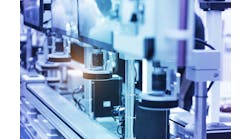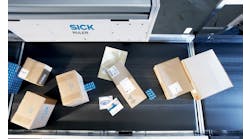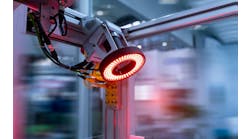Robust and easily maintainable automation solutions are the focus at Global Controls in Saint Charles, Illinois. "Because of that, we spend a great deal of effort in the design and implementation stages," comments Marshall Miles, managing director at Global Control. "This effort refines and simplifies the overall usability in a 24/7 manufacturing environment where technical expertise may be limited."
Global Controls is focused on applying cutting-edge technology to factory automation where increased efficiency and reliability pay the highest dividends. "Whether the product is high-value or high-volume, if the human element is the limiting factor in production, that is where we focus our efforts," notes Miles.
While providing design and integration of a variety of vision inspection systems, Global Controls also is an ABB integrator with experience programming robots, including vision-guided robotics and robot-guided vision applications.
This type of focus and technology is highlighted in Global Controls’ high-speed vision-guided robotic machine used in random pick and oriented, precision place applications (Figure 1). It's a high-speed pick-and-place capable of finding, picking, orienting and placing parts in packages in a variety of existing packaging equipment. Part tracking is also included.
Also read: Combine engineering with innovative methodologies
"This machine is readily configured for placing virtually any discrete item that is durable enough to be recirculated, into a bag or box, oriented or not, either on the fly or in dwell," states Miles. "Depending on the part to be placed, rates of 100 per minute are possible. Plastics, coupons, samples, instructions, inserts and more can be reliably and quickly inserted into a bulk package."
Figure 1: The high-speed robot handles parts that would be difficult to handle manually at the fast cycle rate.
Source: Global Controls
High-value application
A reconfigurable application using this automation is on a packaging line where the product is high-cost and the accurate dosage is provided using a specific measuring cup, according to SKU.
Global Controls’ automated equipment was added to a fill-and-packaging line that, after mixing a batch of the powder, packaged it in a resealable plastic bag for the consumer. A cup is placed on top of the powder before the bag is sealed and sent to the palletizing line.
"The customer wants to be very certain each bag of product contains exactly one correct cup," notes Miles. "And, to complicate things, there are multiple types of cups that needed to be error-proofed based on the product and packaging. Also, if the measuring cup is not placed properly in the bag headspace, the bag may not be sealed properly or the cup may be lost within the product. At 45 bags per minute, this task is difficult to perform manually with the required accuracy. Ultimately without our automation both accuracy and production suffers."
Product and infeed
With scores of different measuring cups associated to hundreds of different SKUs, a single automatic feeder system, as previously available, was unable to handle the variety of products effectively, comments Miles. "The cups vary in size by an order of magnitude, and the variety of shapes and colors are an additional challenge," he explains. "Most automatic feeder systems rely on center of gravity to orient the part. This approach requires a number of feeder systems, each one tuned and maintained for a particular cup geometry."
Our automated machine is unique in that we accept parts in many random orientations for the vision-guided pick, and our end-effector geometry allows a very fast oriented place from the delta robot, continues Miles. "By pre-feeding from a bulk hopper and recirculating conveyor system at a rate much higher than demand, we are able to stay ahead of production, never starving for parts," he says (Figure 2). "Instead of relying on different bowls, rails, chutes and devices, our design is simple and elegant, and no mechanical changeover is required between different product runs."
Figure 2: The hopper feeder and multiple conveyors recirculate parts.
Source: Global Controls
Ideal separation and flow are obtained by controlling the hopper elevator, supply and return conveyor rates and ratios, comments Miles. "These are precalibrated recipes that are called up automatically by SKU," he explains.
"By receiving the batch information directly from the production management system, the only operator setup is to dump the correct cups into the hopper. The operator is guided by a graphic image of the correct cup on the HMI. In the event the wrong cups are loaded, the vision system immediately detects the mismatch, stops the machine and alerts the operator. At the end of a batch the operator runs the system in clean-out mode, and the hopper pre-feeder will quickly unload into a bag or box."
Part handling equipment
Global Controls did an engineering study for the customer to determine the feasibility and to get a headstart on engineering work for the project, notes Miles. "Cycle time and part handling were identified as critical items, and the preliminary testing, both simulated and mocked-up hardware, showed the machine would work," he said. "With customer approval, we moved to the design phase."
The Global Controls machine was designed to interface to a Cloud/Roberts fill-seal machine and place cups in the open bags before they are sealed. The Cloud/Roberts machine prepares and fills the bags with powder before indexing the bags in front of the cup automation for cup insertion.
The cup hopper feed conveyor delivers cups to a series of conveyors that continuously recycle cups through the robot’s picking area monitored by a high-resolution area scan camera. The conveyor configuration simply recirculates cups not oriented correctly.
The high-speed vision-guided robotic application includes three cameras. One camera, a high-resolution Basler area scan camera, along with Cognex VisionPro, guides the ABB delta robot enabling random picks of powder scoops from the infeed conveyor and places them handle down in a bag at a rate of 45 parts per minute.
"We also utilize an Allen-Bradley PLC to communicate to the Cloud/Roberts machine and to the customer’s process control system," comments Miles. "The robot and cameras are connected via EtherNet/IP and controlled by a Rockwell Automation ControlLogix controller.” This automation equipment is also networked to the downstream bagging equipment for control functions.
Vision guidance and inspection
A high-definition Basler GigE area scan camera connected to an industrial PC running Cognex VisionPro machine vision software inspects the cups and guides robotic pickup. The camera is triggered at an adjustable rate and the image is acquired and analyzed with inspection algorithms.
"The vision system identifies cups that are in a favorable orientation, in this case on their sides, for both pickup and inspection," explains Steve Essex, controls engineer at Global Controls. "The vision system inspects selected cups, checking that the cups are the correct parts, using pattern matching and measurement tools. The high-speed vision system then sends the x, y and theta coordinates of cups that passed inspection to the ABB robot for pickup."
An ABB FlexPicker delta, or parallel link, robot can track good parts on the conveyor and pick them on-the-fly, continues Essex. "A custom rotary end effector with vacuum cups is used to pick up the cup," he says. "The scoops will then be oriented by the robot, handle side down, and placed into the open bag. The smallest bags are filled and indexed at a rate of 35 ppm with the equipment designed to operate at 45 ppm or faster, depending on travel distances and parts being handled."
The FlexPicker robot is able to move incredibly fast, up to 10 m/s, in an x-y-z coordinated motion, notes Essex. "The GigE camera and Cognex VisionPro software on an industrial PC are able to run inspections much faster than a stand-alone smart vision sensor with camera imager and processor onboard," he explains. "The PC also runs software from ABB called PickMaster, which greatly simplifies the robot programming that I need to do and ties all the components together seamlessly."
A vision of product verification
Another vision inspection uses a Cognex 5605 In-Sight camera to provide optical character verification (OCV) of a printed lot number and date code. As the bag indexes, it triggers a Videojet printer, which prints these codes. Just downstream of the printer, the Cognex In-Sight camera is triggered by the controller when the conveyor stops each index. The camera reads and verifies the lot number and date code and sends the results to the ControlLogix controller.
A third camera, a Cognex DataMan barcode reader, reads the bag’s two-dimensional ID code. The code is sent via EtherNet/IP to the controller, where it is checked to ensure the bag is correct for the lot number and cup type. High speed, high precision, high error proofing and high traceability come together in this turnkey piece of automation.






